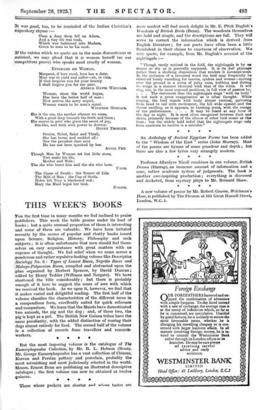Those whose pockets are shorter and whage tastes are more
modest will find much delight in Mr. E. Fitch Daglish's Woodcuts of British Birds (Henn). The woodcuts themselves are bold and simple, and the descriptions are full. They will serve to correct the information which is derived from English literature ; for our poets have often been a little fraudulent in their claims to exactness of observation. We may quote, for example, from Mr. Daglish's account of the nightingale :- 'Though rarely noticed in the field, the nightingale is by no means so shy as is generally supposed. It is its dull plumage rather than a skulking disposition that renders it inconspicuous. In the seclusion of a favoured wood the bird may frequently be observed busily searching for insects, spiders and worms—moving over the ground in a series of jerky runs, bobbing and flirting its wings in a manner identical with that of the robin. It will sing, too, in the most exposed positions, in full view of passers by. . . . The statement that the nightingale sings with its body' is not such a gross exaggeration as is often thought. While singing, the bird stands with body almost vertical, quivering from head to tail with excitement, the bill wide opened and the throat swelling, as it appears, to bursting point, with the energy of the performance. . . . It may be heard at any hour of the day or night. It is most often recognized between dusk and dawn, primarily because of the silence of other bird music at this time ; but the widely held belief that the nightingale sings only from sundown to sunrise is a mistake."


















































 Previous page
Previous page